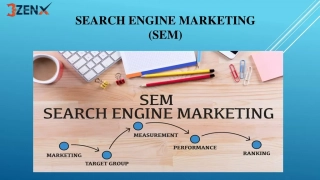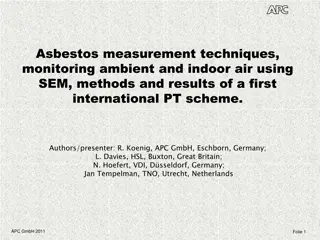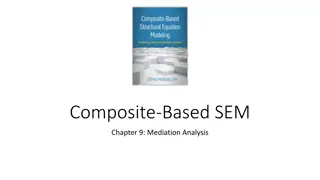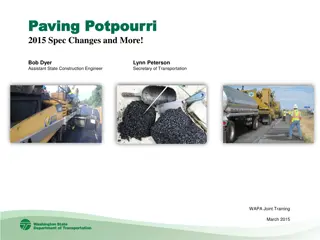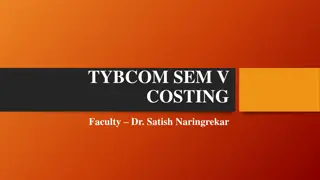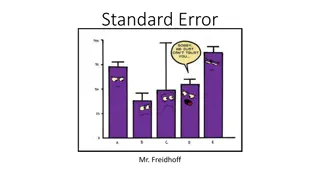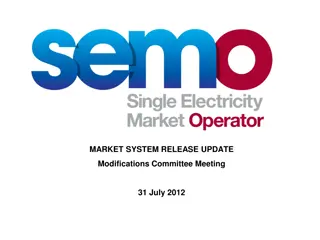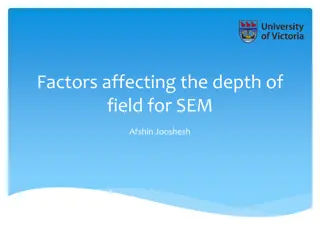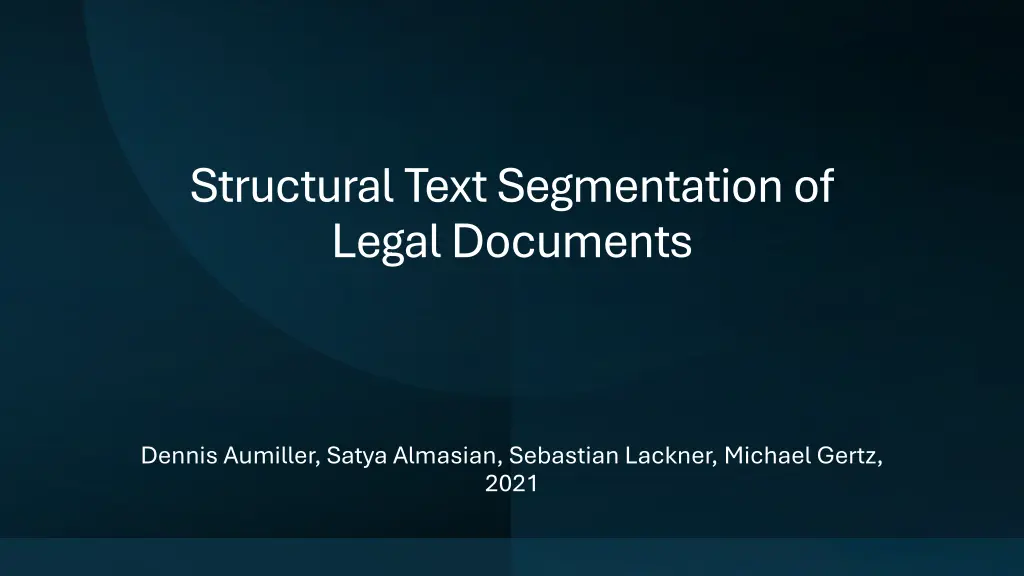
Legal Document Structural Segmentation
This study explores structural text segmentation of legal documents, focusing on transformer-based models for detecting topical changes. The research introduces a new dataset of Terms-of-Service documents partitioned into hierarchical sections. The effectiveness of the generated embeddings for structural segmentations is demonstrated, showing superior performance compared to other text segmentation techniques. The model is evaluated against classical baselines for text segmentation.
Download Presentation

Please find below an Image/Link to download the presentation.
The content on the website is provided AS IS for your information and personal use only. It may not be sold, licensed, or shared on other websites without obtaining consent from the author. If you encounter any issues during the download, it is possible that the publisher has removed the file from their server.
You are allowed to download the files provided on this website for personal or commercial use, subject to the condition that they are used lawfully. All files are the property of their respective owners.
The content on the website is provided AS IS for your information and personal use only. It may not be sold, licensed, or shared on other websites without obtaining consent from the author.
E N D
Presentation Transcript
Structural Text Segmentation of Legal Documents Dennis Aumiller, Satya Almasian, Sebastian Lackner, Michael Gertz, 2021
Abstract Increasing interest in legal information Properly formatted document Lack of context Segments to topics Transformer networks 74000 Terms-of-Servicedocuments Outperforming baselines
Introduction Sequence of semantically coherent segments User are satisfied by retrieving only the relevant subtopic Many legal documents are single text elements PDF or scans, no hierarchical information Topic boundaries more paragraphs Previous works focus only on the sentences Topic boundaries generally do not appear in the middle of a paragraph
NLP large body of existing work Unsupervised, no large labeled datasets, heuristics Topically related words appear in a segment or latent-topic vectors With the availability of annotated data, text segmentation has also been formulated as a supervised learning problem Most methods utilize a hierarchical neural model, where the lower-level network creates sentence representations, and a secondary network models the dependencies between the embedded sentences Introduction Dependency between sentences is modeled in a hierarchical structure, these models fail to take advantage of larger pre-trained language representations, such as BERT and RoBERTa Transformers, Terms-of-Service dataset containing annotated paragraphs Topical coherence is a special case of binary classification of Same Topic Prediction, finetuning transformer Model evaluation against the traditional embedding baselines and compare them to supervised and unsupervised approaches
Contribution (???) frame the task as a collection of independent binary predictions, reducing overhead for hierarchical training and simplified training sample generation. (?) We present the task of structural text segmentation on coarser cohesive text units (paragraphs/sections). (??) We investigate the performance of transformer- based models for topical change detection. (??) We present a new dataset consisting of online Terms-of-Service documents partitioned into hierarchical sections, and make the data available for future research. (??) show the effectiveness of our generated embeddings for structural segmentations to obtain superior performance to other text segmentation techniques. (?) We evaluate our model against classical baselines for text segmentation
LegalDocumentUnderstanding Long history Generally concerned with a specific information extraction, metadata of French law documents HTML/XML structure Clustering techniques na subtopics Clustering for heterogeneous document collections, not focusing on the actual textual content Metadata labels based on a CRF, element classification European case-law decision, sentence embeddings
Topic analysis Topic modeling approaches LDA treats documents as bag-of-words Markovian topic, dependencies between words Rise of distributed word representation, LDA and word embedding Primary segmentation, without predicting topics, focus on the segmentation methods
Text segmentation The task of dividing a document into a multiparagraphdiscourse unit, topically coherent 1994, datasets are small and limit their scope to sentences Choi dataset 920 synthesized passages from the Brown corpus C99 probabilistic algorithm measuring similarity via term overlap GraphSeg TopicTiling (LDA), term frequency vector, PLSA, 218 Wiki dataset Unsupervised learning approaches, small datasets, supervised and43056 LSTM forlearningsentence representationand dependencies, cleanedWikipedia articles, Coherence-AwareText Segmentation, encodes a sentence sequence using two hierarchically connected transformer networks They rely on per sentence predictions, incomparable to paragraph-based method.
Transformer Language Models Like revurrent NN, it aims to solve sequence-to-sequence tasks, relying on self-attention to compute representations of its input and output Significant step in bringing transfer learning to the NLP community Easy adaptation of a generically pre-trained model for specific tasks BERT, GPT-2, RoBERTa language modeling for pre training Powerful feature generators Sentence-BERT combines two BERT-based models in Siamese fashion, semantically meaningful sentence embedding RoBERTa retraining of BERT Sentence-RoBERTa
Same topic prediction Supervised learning task of the same topic prediction, two steps: Independent and Identically Distributed Same Topic Prediction (IID STP) Sequential inference over a fulldocument Sub-sections are ignored , but have data First step, fine-tune transformer-based models to detect topical change for both paragraphs and entire sections Second step, segment boundaries by topical change
IID Same Topic Prediction (STP) document? D sequence of ? sections ??= (?1, ..., ??) ? topics? = (?1, ..., ??) ? paragraphs??= (?1, ....??) Topical consistency within a paragraph, positionof the paragraph ??= (?1, .., ??) ?????(??) = ?1= ?????(?1) = ?1= ... = ?????(??) = ?1
IID Same Topic Prediction (STP) C chunk of text c1, c2 (p or s) andlabels 0, 1 binary classification problem 1 same topic, 0 change BCP any type of classifier Pre-trained and Siamese
RoBERTa Replication study of BERT, pre-training with optimized hyper-parameters Transformer shaping a sequence, self-attention mechanism, extract features from each word in the context Self-attention blocks, feed-forward network Pre-training: two sentences, two tasks, predicting masked words, classifying the senctences Models learn tesk-independent features Fine-tuning: two chunks, CLS, SEP tokens
SRoBERTa Sentence-transformer, semantically meaningful sentence embeddings, Siamese architecture Large-scale semantic similarity comparison Faster, better Siamese + 2 RoBERTas = double input size Embeddings from pooling operation of two models Classification objective function with binary cross-entropy loss
Sequential inference Previous classifiers, sequential classification Section breaks marked ??(?1, ?2) = ?(?????(?1) = ?????(?2)) Predicted labels ? = (?1, ..., ?? 1 ) A segmentation of the document is given by ? 1 predictions of ??, where ??= 0 denotes the end of a segment by ?I
Legal application SECTION-BASED SEMANTIC SEGMENTATION AS A PRE-PROCESSING STEP FOR PASSAGE RETRIEVAL ADDITIONAL DATA REQUIRED SIMILARITY SEARCH F. E. RELATED SECTIONS IN CONTRACTS DOCUMENT OUTLINES -WIKIPEDIA
Terms-of-Service dataset Legal information for site users Automatically extract the paragraphs Shared set of topics
Crawling Landing page with Beautiful Soup Python package Alexa 1M URL dataset, www Hyperlinks, Levenshtein distance of 0,75 Raw HTML is downloaded JavaScript not supported 74000 websites
Non-trivial task Section extraction Boilerplate removal boilerpipe package HTML cleanup - <p> Language detection langid package Extracting hierarchy split by <h1><h6>, <b>, <li>, <u>, <p>, at least 5 occurencies, headings saved, enumeration patterns
Data set statistics Cleaned subset with manually grouped sections 554 section titles, 82 topics Only top-level sections 80/10/10 train/validation/test Avg number of sections is 6,56 and 22,32 paragraphs 2,92 paragraphs per section
Baselines: Global Vectors (GLVavg) tf-idf vectors (tf-idf) Bag of Words (BoW) Transformer models: CLS sequence classification with roberta-base (Ro-CLS) Sentence-transformers: roberta-base (ST-Ro), ST-Ro-NLI Training with HuggingFace, Siamese 1024 tokens Evaluation
Train with an independent classification setup Same section prediction task Not directly comparable 3 sampling strategies 3 positive and 3 negative samples for each section Same Section prediction, Random paragraph, Consecutive Paragraph sampling Prediction tasks
Multitude of previous works Interface Conclusion and future Deeper hierarchical sections Relaxation of the problem work Transformer- based models outperform text segmentation baselines Sequential setup to supervised Same Topic Prediction task ToS dataset

